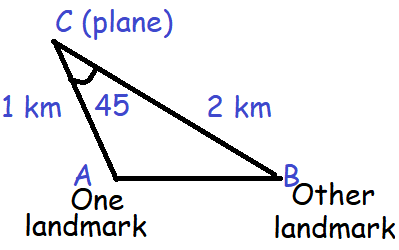LAWS OF SINES AND COSINES PRACTICAL PROBLEMS
Problem 1 :
A plane is 1 km from one landmark and 2 km from another. From the planes point of view the land between them subtends an angle of 45°. How far apart are the landmarks?
Solution :

We have to find the length of AB.
a = 2 km (Opposite to angle A)
b = 1 km (Opposite to angle B)
c = AB (Opposite to angle C)
Cosine formula :
cos C = (a2 + b2 - c2) / 2ab
cos 45 = (22 + 12 - c2) / 2(2)(1)
1/√2 = (5 - c2) / 4
5 - c2 = 4/√2
5 - c2 = 2√2
c2 = 2√2 + 5
c = √(2√2 + 5)
Problem 2 :
A man starts his morning walk at a point A reaches two points B and C and finally back to A such that ∠A = 60◦ and ∠B = 45◦, AC = 4 km in the triangle ABC. Find the total distance he covered during his morning walk.
Solution :

<A + <B + <C = 180
60 + 45 + <C = 180
<C = 180 - 105 = 75
a/sin A = b/sin B = c/sin C
a/sin 60 = 4/sin 45 = c/sin 75 ----(1)
First let us find "a".
a/sin 60 = 4/sin 45
a/(√3/2) = 4/(1/√2)
2a/√3 = 4√2
a = 4√2√3/2
a = 2√6
By applying a = 2√6 in (1) and find c.
2√6/sin 60 = c/sin 75
2√6/(√3/2) = c/sin 75
sin 75 = sin (45 + 30)
= sin 45 cos 30 + cos 45 sin 30
= (1/√2) (√3/2) + (1/√2)(1/2)
= (√3 + 1)/2√2
4√2 = c/(√3 + 1)/2√2
4√2 = 2√2c/(√3 + 1)
c = 4√2(√3 + 1)/ 2√2
c = 2(√3 + 1)
Total distance covered = 2√6 + 4 + 2(√3 + 1)
= 2√6 + 4 + 2√3 + 2
= 2√6 + 6 + 2√3
Problem 3 :
Two vehicles leave the same place P at the same time moving along two different roads. One vehicle moves at an average speed of 60 km/hr and the other vehicle moves at an average speed of 80 km/hr. After half an hour the vehicle reach the destinations A and B. If AB subtends 60◦ at the initial point P, then find AB.
Solution :
Distance covered by A = time x speed
= (1/2) ⋅ 60
= 30 km
Distance covered by B = time x speed
= (1/2) ⋅ 80
= 40 km

cos C = a2 + b2 - c2/2ab
cos 60 = 402 + 302 - c2/2(40)(30)
1/2 = (1600 + 900 - c2)/2400
1200 = 2500 - c2
c2 = 2500 - 1200 = 1300
c = √1300
c = 10√13
Hence the distance of A and B is 10√13 km.
Problem 4 :
Suppose that a satellite in space, an earth station and the center of earth all lie in the same plane. Let r be the radius of earth and R be the distance from the center of earth to the satellite. Let d be the distance from the earth station to the satellite. Let 30◦ be the angle of elevation from the earth station to the satellite. If the line segment connecting earth station and satellite subtends angle α at the center of earth , then prove that d = R√1 + (r/R)2 − 2 (r/R) cos α.

Solution :
Let A be the center, B be the station and C be the satellite position.
a/sin A = b/sin B = c/sin C
a = d, b = R and c = r
d/sin a = R/sin 30 = r/sin (180 - (30 +a))
cos A = (b2 + c2 - a2)/2bc
cos a = (R2 + r2 - d2)/2Rr
2Rr cos a = R2 + r2 - d2
d2 = R2 + r2 - 2Rr cos a
d = √(R2 + r2 - 2Rr cos a)
d = √(R2 (1 + (r/R)2 - 2(r/R) cos a
d = R√(1 + (r/R)2 - 2(r/R) cos a)
Hence proved.
Kindly mail your feedback to v4formath@gmail.com
We always appreciate your feedback.
©All rights reserved. onlinemath4all.com
Recent Articles
-
Digital SAT Math Problems and Solutions (Part - 146)
Apr 18, 25 06:52 AM
Digital SAT Math Problems and Solutions (Part - 146) -
Logarithmic Derivative Problems and Solutions
Apr 16, 25 09:25 PM
Logarithmic Derivative Problems and Solutions -
Digital SAT Math Problems and Solutions (Part - 145)
Apr 16, 25 12:35 PM
Digital SAT Math Problems and Solutions (Part - 145)

